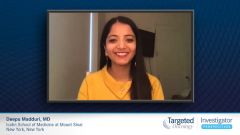
ASH 2020 Update: Phase 1b/2 CARTITUDE-1
Clinical updates from the phase 1b/2 CARTITUDE-1 study of ciltacabtagene autoleucel (cilta-cel) for relapsed/refractory multiple myeloma.
Deepu Madduri, MD: I’m going to discuss the CARTITUDE-1 data that were recently presented at ASH [the American Society of Hematology 2020 annual meeting]. CARTITUDE-1 is a study of JNJ-4528, now known as ciltacabtagene autoleucel, or cilta-cel. This is a structurally distinct second-generation chimeric antigen receptor [CAR] T-cell therapy with 2 specific BCMA-binding domains. During past meetings, at ASCO [the American Society of Clinical Oncology], particularly, we presented the phase 1b portion of the study, and today I’ll be discussing the combined phase 1b and phase 2 study of CARTITUDE-1.
The primary objective of the phase 1b study was to characterize the safety of ciltacabtagene autoleucel and confirm its recommended phase 2 dose. The primary objective of the phase 2 study was to evaluate its efficacy.
In regard to key eligibility criteria, patients had to have progressive multiple myeloma per IMWG [International Myeloma Working Group] criteria and a good performance status. They also had to have measurable disease and had to have been exposed to at least 3 or more prior therapies—such as a PI [proteasome inhibitor], an IMiD [immunomodulatory imide drug], and an anti-CD38 antibody—or be double refractory.
Once the patient is screened and enrolled, they all undergo apheresis and are offered bridging chemotherapy as needed. Then the patients all undergo lymphodepleting chemotherapy with fludarabine and cyclophosphamide from day-minus-5 to day-minus-3 and get infused with ciltacabtagene autoleucel, with a target dose of 0.75 x 106 CAR T cells/kg of body weight.
In this study, we treated 97 patients in the combined phase 1b/phase 2 portion. Out of the 97 patients, the median age was 61 and half of them were male. If you looked at how heavily pretreated these patients were, you can see that their prior lines of therapy were 6, ranging anywhere from 3 to 18. Eighty-eight percent of these patients were triple refractory, and 42% of these patients were penta refractory.
One of the things I wanted to point out is that these patients were not required to be refractory to their last line of therapy for enrollment, but indeed, 99% of these patients were refractory to their last line of therapy. If you broke the refractory status down further, you can see that 65% of these patients were carfilzomib refractory, 84% were pomalidomide refractory, and 99% were anti-CD38–refractory.
Transcript edited for clarity.










































